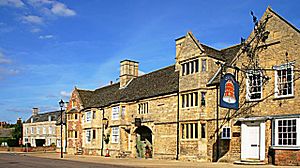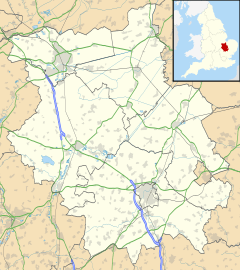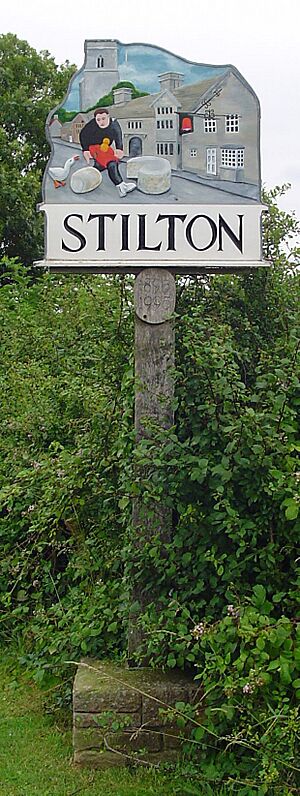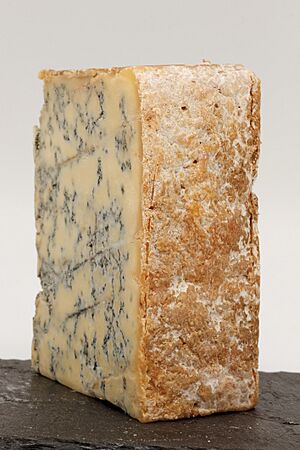Stilton facts for kids
Quick facts for kids Stilton |
|
|---|---|
 The Bell Inn |
|
| Population | 2,455 (2011 census) |
| OS grid reference | TL162893 |
| District | |
| Shire county | |
| Region | |
| Country | England |
| Sovereign state | United Kingdom |
| Post town | PETERBOROUGH |
| Postcode district | PE7 |
| Dialling code | 01733 |
| Police | Cambridgeshire |
| Fire | Cambridgeshire |
| Ambulance | East of England |
| EU Parliament | East of England |
| UK Parliament |
|
Stilton is a village and civil parish in Cambridgeshire, England. It is about 12 kilometres (7.5 miles) north of Huntingdon. Stilton is part of Huntingdonshire, which is a district in Cambridgeshire. It is also known as a historic county of England.
Contents
A Look Back: Stilton's History
People have lived in the Stilton area since the Neolithic period. This was a very long time ago! Archaeologists have found old Roman items in the village. These include a silver ring and a jug from the 2nd century. They also found what might be a Roman settlement and a Roman cheese press.
Stilton in the Domesday Book
Stilton was mentioned in the Domesday Book in 1086. This was a big survey ordered by William the Conqueror. The village was called Stichiltone or Sticilitone back then. It was part of the Normancross area in Huntingdonshire.
In 1086, there were three main estates, called manors, in Stilton. The yearly rent paid for these manors was £4 in 1066 and stayed the same in 1086. The Domesday Book did not count people directly. But it said there were ten households in Stilton. If each household had 3.5 to 5 people, then about 35 to 50 people lived there.
The Domesday Book used old measurements for land. A "hide" was an area of land that could support one family. It was also used to figure out taxes. A "ploughland" was how much land a team of oxen could plough in a season. Stilton had about 6.37 ploughlands and room for more. It also had 32 acres of meadows and 10 acres of woodland.
Taxes in Old Stilton
The tax in the Domesday Book was called "geld" or "danegeld". It was a land tax. It first helped pay off the Danes when they attacked England. After the Norman conquest, it raised money for the king. By 1130, this tax was collected every year. The total tax for Stilton's manors was five geld.
In 1086, there was no church in Stilton.
Coaching Inns: A Busy Stop
The old Roman road, Ermine Street, was very important for Stilton. It later became the Great North Road. Stilton grew into a popular stop for coaches and travellers. At one point, there were 14 pubs in the village. This was a lot for a population of only about 500 people!
The main inns were the Bell Inn and the Angel Inn. Both are still there today. The Bell Inn has been around since 1515 and was rebuilt in 1642. The Angel Inn started in the early 1600s. It was rebuilt as a large brick house in the 1700s. It stopped being an inn and was badly burned in 1923. Fires also damaged the village in 1729, 1798, and 1895.
Modern Times and Changes
Stilton depended a lot on its location on the Great North Road. When the road became less used, the village faced problems. First, the railway arrived in the 1800s. This meant fewer goods were carried by road. Then, in 1958, a new bypass road for the A1 opened. This bypass took traffic away from the village.
The Bell Inn closed down and fell apart. Many businesses in the village struggled. To help bring interest back, a cheese-rolling race started in 1962. It was held every May Day holiday. However, the race was cancelled in 2018. This was because fewer people were interested, and some behaviour became hard to control. Also, photos showed that small logs were being rolled, not actual cheeses.
The name Stilton means "village at a stile or steep ascent".
How Stilton is Governed
Stilton is a civil parish. This means it has a parish council. This council is elected by the people who live in the parish. The parish council is the lowest level of government in England. It collects its own tax, called the parish precept, to pay for some services. This tax is part of the Council Tax. The council has twelve councillors and a parish clerk. They usually meet on the second Tuesday of each month, except in August.
Changes in Local Government
Stilton was part of Huntingdonshire until 1965. From 1965 to 1974, it was part of a new area called Huntingdon and Peterborough. Then, in 1974, Stilton became part of Cambridgeshire county. This happened because of the Local Government Act 1972.
The next level of local government is Huntingdonshire District Council. This council has its offices in Huntingdon. It has 52 councillors who represent different areas. Huntingdonshire District Council collects the main council tax. Stilton is one of these areas and has one councillor. These councillors serve for four years.
The highest level of local government for Stilton is Cambridgeshire County Council. Its buildings are in Cambridge. This council provides services for the whole county. These include major roads, fire and rescue, education, and libraries. Cambridgeshire County Council has 69 councillors. Stilton is part of the Norman Cross area, which has two councillors.
At the national level, Stilton is in the North West Cambridgeshire area. This area elects one Member of Parliament (MP) to the UK Parliament. The MP is chosen by the "first past the post" system. This means the person with the most votes wins.
Stilton's Location
Stilton is south of the city of Peterborough. It is on the old Great North Road, about 70 miles (113 kilometres) from London. It is just south of Norman Cross. In 1998, a new motorway, the A1(M), bypassed the village. Now, you can only get to Stilton from the A15 road at Norman Cross.
Stilton is twinned with Saint-Christol-lès-Alès. This is a community in the south of France.
Population of Stilton
Between 1801 and 1901, the number of people living in Stilton changed. The lowest number was 509 in 1801. The highest was 817 in 1841.
Since 1901, a census has been taken every ten years. The only exception was 1941, because of the Second World War.
| Parish |
1911 |
1921 |
1931 |
1951 |
1961 |
1971 |
1981 |
1991 |
2001 |
2011 |
|---|---|---|---|---|---|---|---|---|---|---|
| Stilton | 491 | 455 | 494 | 672 | 633 | 911 | 1,782 | 2,151 | 2,425 | 2,455 |
All population census figures are from the report Historic Census figures Cambridgeshire to 2011 by Cambridgeshire Insight.
In 2011, the parish of Stilton covered an area of 1,633 acres (661 hectares). This included the nearby area of Folksworth.
Stilton Cheese: A Famous Name
The village of Stilton gave its name to Stilton cheese. Most people believe the cheese was sold at the coaching inns in Stilton. Travellers passing through would buy it there. In 1722, writer Daniel Defoe said the village was famous for its cheese. It was thought that the cheese came from a housekeeper at Quenby Hall in Leicestershire. She sold it through her brother-in-law to people at the Bell Inn or Angel Inn.
Today, Stilton village is not allowed to make Stilton cheese. This is because it is not in one of the three counties licensed to make it. These counties are Derbyshire, Leicestershire, and Nottinghamshire. The cheese makers in these counties got a special status in 1996. This is called Protected Geographical Status (PGS). It means only cheese made in these three counties, using pasteurised milk, can be called Stilton cheese.
New information suggests that cheese might have been made in the Stilton area itself. An old recipe for a cream cheese made in Stilton in the early 1700s has been found. Since more than one type of cheese was usually made, a blue cheese might also have been made there. The Parish of Stilton has tried to get permission to be included in the protected area. They have not been successful so far. Shailesh Vara MP, the local Member of Parliament, has supported these efforts.
The Village Church
There is no record of a church in Stilton before the 1200s. The oldest parts of the current Parish Church of St Mary Magdalene are from that time. Most of the church was built in the 1400s. It has a chancel (the area around the altar), a nave (the main part of the church), and aisles on the north and south sides. It also has a west tower and a south porch. It is a Grade II* listed building, which means it is very important historically.
Life in Stilton Village
Stilton has its own Church of England primary school. The village has one shop and three pubs: The S Bar, The Bell, and The Talbot. There is also Colbrook's, a special garage for Rolls-Royce and Bentley cars.
Images for kids
Error: no page names specified (help). In Spanish: Stilton (Cambridgeshire) para niños
In Spanish: Stilton (Cambridgeshire) para niños






